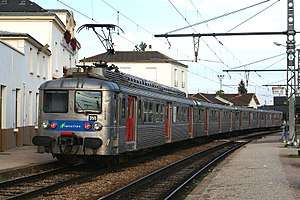SNCF Class Z 5300
SNCF Class Z 5300 are three and four car Electric Multiple Unit type for Paris commuter and regional services. They were built by Carel et Fouche, MTE/Francorail, Fives-Lille and OC Oerlikon between 1965-1968 (1st batch) and 1972-1975 (2nd batch). Many of these trains have been withdrawn starting from 2003.
| SNCF Class Z 5300 | |
|---|---|
 A refurbished Z 5300 train in September 2006 | |
| In service | 1965–present |
| Manufacturer | Carel et Fouché, MTE/Francorail, Fives-Lille, OC Oerlikon |
| Constructed | 1965–1975 |
| Refurbished | 1978, 1992, 2005–2007 |
| Scrapped | 2003– |
| Number built | 145 cars |
| Number in service | 24 cars (as of 15 January 2017) |
| Number scrapped | 121 cars |
| Formation | 3 or 4 cars per trainset |
| Operator(s) | SNCF |
| Specifications | |
| Width | 2.87 m (9 ft 5 in) |
| Height | 4.205 m (13 ft 9 9⁄16 in) |
| Doors | 3 pairs per side |
| Maximum speed | 130 km/h (81 mph) |
| Electric system(s) | 1,500 V DC Overhead line |
| Current collection method | Pantograph |
| Track gauge | 1,435 mm (4 ft 8 1⁄2 in) standard gauge |
Characteristics
These stainless steel-bodied EMUs were built as 4-car units including a driving motor car, two intermediate trailers and a driving trailer. However, some units were shortened to three or two cars by removing one or both of the intermediate trailers. Up to three elements can be coupled together to form a 12-car trainset.[1] The power supply is 1500 V DC with electromechanical traction equipment.
Livery
As the use of stainless steel eliminates the need for painting, the units are basically silvery, with originally only an orange stripe between the headlights. They are therefore nicknamed petit gris (i.e. "little gray", but also the name of a snail), couscoussière, "silver arrow" or "tin can". However, as some units were modified, the doors were painted red, light blue or dark blue according to the services they were intended for. Since 2011, only red-doored units subsist; red doors mean that the unit is fitted with EAS (exploitation à agent seul, i.e. "single crew operation"), and may be operated without a guard.
Operation
Current
As of 2015, Z 5300s are operating on two commuter services in the south-east of Paris:
- Melun-Juvisy (RER D), and
- Melun-Montereau through Héricy (Transilien, R line).
Discontinued
This class used to operate on many other services, but has been replaced by more recent stock. Such services include:[1]
- Paris-Lyon-Montereau,
- Paris-Lyon-Montargis,
- Paris-Montparnasse-Rambouillet,
- Paris-Montparnasse-Plaisir-Grignon,
- Commuter services on the southern part of RER C,
- Paris-Montparnasse-Chartres,
- Paris-Montparnasse-Le Mans,
- Paris-Austerlitz-Orléans,
- Shuttle services between Orléans and Les Aubrais (connection with mainline services) with 3-car elements,
- Shuttle services between Tours and Saint Pierre des Corps on the same principle.
Accidents
Gallery
- Z 5423 arriving at Tours
 A Z5300 and Z20500 at Corbeil-Essonnes.
A Z5300 and Z20500 at Corbeil-Essonnes. Z 5353 on a passenger service.
Z 5353 on a passenger service. Z 5310 is seen at Juvisy on RER line D
Z 5310 is seen at Juvisy on RER line D
References
- Olivier Constant (2014). Encyclopédie du matériel moteur SNCF - tome 10 : les automotrices à courant continu 1500 V. Éditions Publitrains. "Les Z 5300", p.46.
- "INTERVIEW ROUVILLOIS (SNCF)". INA.fr (in French). Retrieved 2020-05-28.
- Haydock, David; Fox, Peter [1999]. European Handbook No. 4 French Railways Locomotives & Multiple Units, Third Edition, Sheffield, UK: Platform 5 Publishing Ltd.. ISBN 1-872524-87-7.